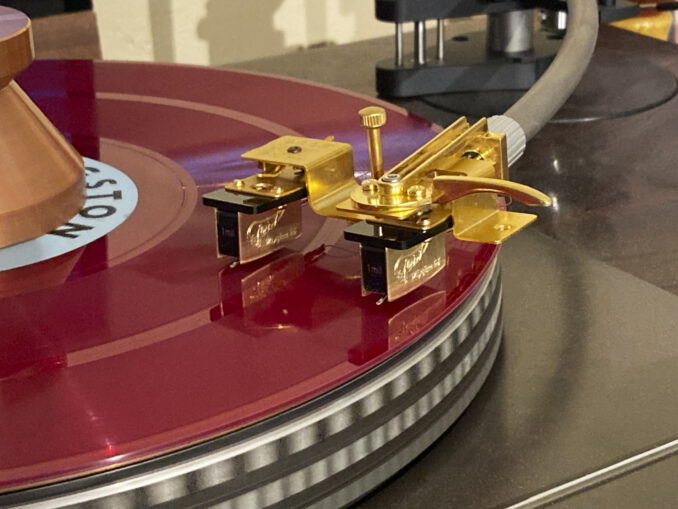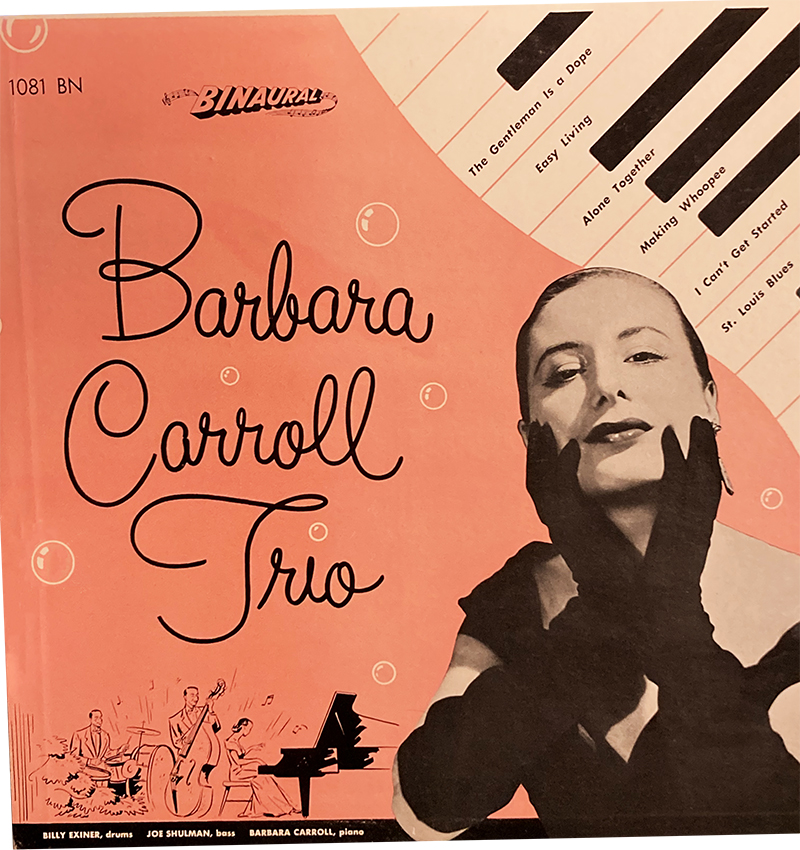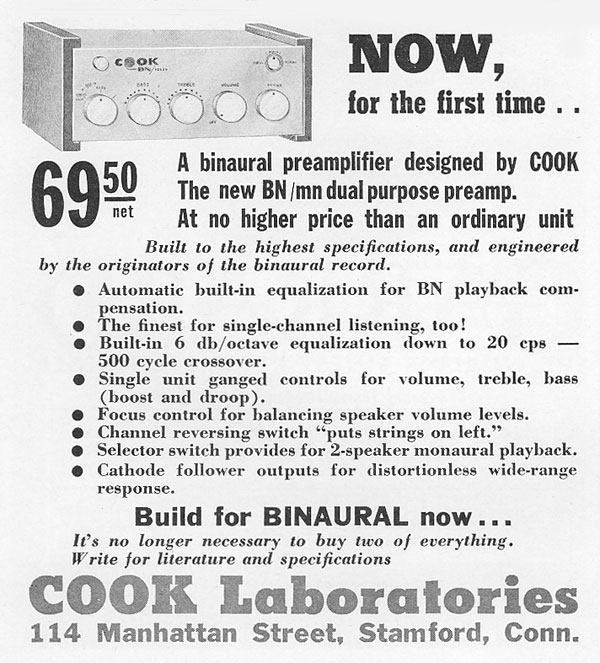
I recently had the rather unique pleasure of listening to a stereo LP of the Barbara Carroll Trio released in 1954 by the Livingston Electronic Corporation, a full four years before the major labels got to stereo.

From the Library of Congress Press Release:
Binaural Stereo demonstration – In 1952, Emory Cook put stereo on vinyl for the first time, six years ahead of the major labels. It was expensive and cumbersome, requiring a two-headed tonearm to play separate channels pressed onto a disc, but it worked beautifully. Engineers Robin Wyatt and Tom Fine have recreated Cook’s system with a combination of original and modern gear and will play selections from Cook’s Binaural Stereo catalog and discuss his work and theirs.
And from Wikipedia:
Cook’s sound was achieved by putting the output from two separate microphones on two independent monaural tracks on the same side of a record. On these records, the grooves of the first channel formed a single “band” that was concentric with and surrounded a second band that started about halfway into the record and which contained the grooves of the second stereo channel.

In order to listen to a Livingston “Binaural” recording, you need one of Emory Cook’s two-headed cartridge holders, aka Binaural Adapter or Cook’s Binaural Conversion Arm, to read the grooves from two separate monophonic bands on the record’s surface. What’s more, you also need Cook’s Binaural Preamplifier to unpack both channels properly.

I bet you’re wondering—How’d it sound? I got to hear Cook’s rig and this record at hifi dealer Robin Wyatt’s place, Robyatt Audio, and let me tell you, it was flat out lovely.
Let’s take a brief detour with Vinny Gallo from his article “Mono Mia” from Sound Practices magazine’s Summer 1992 edition:
Think about it. Are mechanical and electrical reproducers supposed to take the place of live music? NO, they’re not. They are what they are. They are their own thing. They have their own place in our lives and they shouldn’t even be compared to live music. I really believe that great hi-fi should sound like the best radio you ever heard. Great hi-fi affects your ears and emotions in its own way, reminding you of sounds and sound impressions.
…
Hi-fi is its own beautiful thing and for me the more simple it is the better. Mono, that’s right, MONO. Ya heard me, Monophonic. For years people listened to it and loved it. But some hustlers told us stereo was better while they were selling us two of everything. Well, it’s not. Trust me. It might be more but it’s not better.
Listening to the Barbara Carroll Trio through the Cook Binaural system was like getting the best of both worlds—the density and impact of mono coupled with the space and place of stereo! Yes, the setup of that dual-headed Binaural Adapter is a bit fidgety and Cook only released 50 Binaural records (released by Cook Labs, Livingston, Audiosphere, and Atlantic), Robin has them all plus every test record Cook produced, but as an experience it ranks right up there with the most fascinating.
This also acted as a friendly reminder that connecting to music in a meaningful way is not limited to any particular technology.
Here’s the complete press release from the Library of Congress:
From Cylinders to Surround Mixes: Daylong Demonstration Features Sound and Preservation at the Library of Congress, August 24, 2023
Special Sound Installation, Presentations to Highlight Library’s Audio Collections
The Library of Congress will showcase a range of treasures, technology and history from its recorded sound collection, the largest such audio collection in the world, in a daylong series of presentations and evening sound installations on Aug. 24.
Throughout the day, sound engineers and recording historians will present on a unique set of topics covering some of the earliest, most important and most unusual sounds in the Library’s holdings in the Whittall Pavilion and Room 119 of the Thomas Jefferson Building. Displays and presentations will include early experiments on cylinders through the many eras of radio broadcasting and the ongoing quest to expand the possibilities and achievements in recording. Visitors will hear an amazing range of sounds and the stories behind them.
Free timed-entry passes are required to enter the Thomas Jefferson Building. Visit loc.gov/visit to reserve your pass. The evening demonstrations and sound installation will be presented as part of Live at the Library, the Library’s Thursday evening series.
Presentations in Room 119:
10 – 10:45 a.m.: A Lasting Impression – The Cylinder Era of Recording – David Sager, reference specialist, and Melissa Widzinski, preservation specialist, National Audio-Visual Conservation Center, look at the history and preservation of the first commercial recordings.
11 – 11:45 a.m.: The 20th Century on the Radio at the Library of Congress – Matthew Barton, recorded sound curator, National Audio-Visual Conservation Center, reviews highlights of history and entertainment in the Library’s radio broadcast collection.
1:30 –2:15 p.m.: Recording World War II on Wire and Film in the 1940s – sound engineer Nick Bergh discusses his work with the National Audio-Visual Conservation Center’s collection of Marine Combat Recordings .
2:45 – 3:30 p.m.: The Stereo Era begins, 1952 – 1960 – Matthew Barton, and sound engineer Tom Fine explore the progression from mono to stereo in the Hi- Fi era.
4:00 – 4:45 p.m.: Les Paul and the Early Days of Multi-Tracking – Grammy winning record producer and sound engineer Steve Rosenthal discusses the preservation work on Les Paul’s collection of recordings at the National Audio-Visual Conservation Center in 2017-18, and curator Perry Margouleff displays Les Paul guitars integral to his recording process
Presentations in Whittall Pavilion:
10 a.m.: Binaural Stereo demonstration – In 1952, Emory Cook put stereo on vinyl for the first time, six years ahead of the major labels. It was expensive and cumbersome, requiring a two-headed tonearm to play separate channels pressed onto a disc, but it worked beautifully. Engineers Robin Wyatt and Tom Fine have recreated Cook’s system with a combination of original and modern gear and will play selections from Cook’s Binaural Stereo catalog and discuss his work and theirs.
11 a.m.: Quadraphonic demonstration – from the late 1960s to the late 1970s, four channel Quadraphonic mixes of music in every genre were the stuff of legend and heated debate. Sound engineer Rob Cristarella has curated a selection of the best and most unusual Quadraphonic selections of the era,
The Binaural and Quadraphonic demonstration will be repeated throughout the day, alternating on the hour, with the last demonstration at 5 p.m.
6 and 7 p.m.: Surround sound history and demonstration – National Audio-Visual Conservation Center Record Lab Supervisor and Grammy winning sound engineer Rob Friedrich will discuss and demonstrate the history of multichannel sound mixing from the early days of stereo to today 5:1 surround mixes.
Sound Installations on Mahogany Row, 5-8 p.m.
In the rooms along Mahogany Row, visitors will hear montages and live original format playback of recordings from the 1890s to the present that have been digitized at the National Audio-Visual Conservation Center, as well as playback of original media. Visitors will hear the voices of opera greats such as Enrico Caruso and Amalia Galli-Curci alongside the early jazz recordings of Louis Armstrong and other artists from the 1900s to the 2000s, recordings in the many languages and traditions in American music recorded from the dawn of the 20th Century forward, as well as historic broadcast excerpts from the Library’s vast radio holdings. In addition, visitors will hear demonstrations of multichannel audio from the early days of stereo in the 1950s through the four-channel quadraphonic era of the 1970s through recent surround mixes.
Room 110: Live cylinder playback demonstration
Room 111: Live 78 rpm playback demonstration
Room 112: Pre-recorded audio montages
Room 113: Visual display room with original equipment, original formats
Room 119: Display of Les Paul’s own guitars, used in his historic recordings

